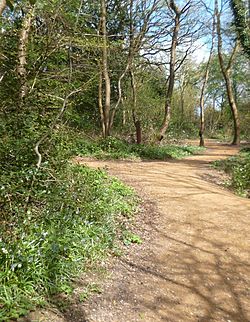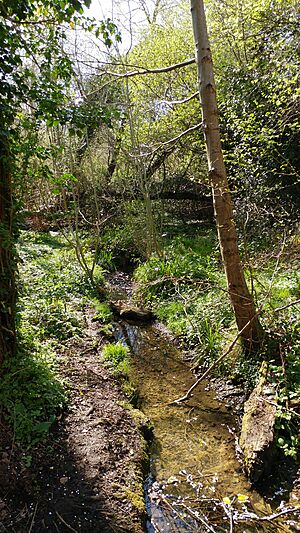Blundells Copse facts for kids
Quick facts for kids Blundells Copse |
|
|---|---|

Path through Blundells Copse
|
|
| Lua error in Module:Location_map at line 420: attempt to index field 'wikibase' (a nil value). | |
| Type | Local nature reserve |
| Location | Tilehurst, Reading, UK |
| Area | 5.55 hectares (13.7 acres) |
| Created | 1992 |
Blundells Copse is a special place in Tilehurst, a part of Reading, UK. It's called a local nature reserve. This means it's a protected area for nature. It covers about 5.55 hectares, which is like 10 football fields! It's an old woodland with lots of trees growing close together and a stream flowing through it.
The Reading Borough Council helps look after Blundells Copse. It's also part of a bigger group of green spaces called West Reading Woodlands. This group includes Lousehill Copse and McIlroy Park.
Contents
What is the History of Blundells Copse?
Blundells Copse used to be part of a larger area called "the Moor." In 1992, it officially became a local nature reserve. This helped protect its natural beauty.
Later, in 2005, some paths were made wider and better. This was possible thanks to money from Living Spaces and the Environmental Trust for Berkshire. These improvements make it easier for people to explore and enjoy the reserve.
What Animals Live in Blundells Copse?
"Fauna" is a word for all the animals that live in a certain area. Blundells Copse is home to different kinds of animals.
Mammals
- European hedgehog: These small, spiky animals are known for rolling into a ball when scared.
- Muntjac: These are small deer, sometimes called barking deer because of the sounds they make.
What Plants and Trees Grow Here?
"Flora" is a word for all the plants and trees that grow in a certain area. Blundells Copse has many different types of plants and trees.
Trees
- Alnus glutinosa (Alder): These trees often grow near water.
- Prunus avium (Wild Cherry): This tree produces small, edible cherries.
- Quercus robur (Oak): A very common and strong tree in the UK.
- Fraxinus (Ash): These trees are known for their strong wood.
- Hazel: Hazel trees produce tasty nuts.
Plants
- Hyacinthoides non-scripta (Bluebell): These beautiful blue flowers often cover woodland floors in spring.
- Chrysosplenium oppositifolium (Opposite-leaved Golden-saxifrage): A small plant that likes wet, shady spots.
- Caltha palustris (Marsh Marigold): A bright yellow flower that grows in wet areas.
- Lamium galeobdolon (Yellow Archangel): This plant has yellow flowers and can spread quickly.
- Apium nodiflorum (Fool's Water-cress): A plant that grows in wet places, similar to watercress.
- Allium triquetrum (Three-cornered Leek): This plant has white bell-shaped flowers and smells like garlic.
- Adoxa moschatellina (Moschatel): Also known as Townhall Clock, a small plant with unusual green flowers.
- Zantedeschia (Arum Lily): A plant known for its large, often white, funnel-shaped flowers.


